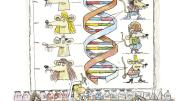Of all the seed-bearing plants on earth, the angiosperms, or flowering plants, have been the most successful. There are 250,000 of them, as compared to a mere 750 of everything else: a group that includes conifers, cycads, and the gingko treein a family of its own. Almost everything we eat except meat is a flowering plantall the fruits, vegetables, and grains, for example. The rise of the angiosperms 140 million years ago, in the early Cretaceous period, had an enormous impact on the biosphere, affecting the evolution of all the major groups of organisms, including insects, birds, and mammals. As tropical rainforests emerged, even the earths climate changed.
Scientists have long wondered what led to the angiosperms rapid radiation and diversification. Charles Darwin called their sudden appearance in the fossil record "the abominable mystery." Fossils show that "by the mid to late Cretaceous, flowering plants had pretty much taken over: the diversity of other plant groups was low and the diversity of the angiosperms was very high," says professor of biology Michael Donoghue, Ph.D. 82, former director of the Harvard University Herbaria.
Donoghue and research associate Sarah Mathews, the worlds leading expert on phytochrome gene diversification in plants, recently announced in Science magazine a major discovery: they had identified the most ancient lineages in the angiosperm family tree, a key step in understanding their evolutionary success. Knowing which of todays flowering plants are most closely related to the earliest angiosperms can help scientists determine what their progenitors looked like, where they lived, how they reproduced, and how their seeds were dispersed; whether they were woody or herbaceous; what their flowers and leaves looked like; and whether they lived in wet or dry places.
Their work has brought botanical stardom to an obscure plant named amborella, which grows only on the South Pacific island of New Caledonia. Amborella trichopoda is a woody shrub with evergreen leaves and tiny flowers (smaller than a pencil eraser), living in the islands open tropical forest. Like the gingko, each plant is either male or female, but occasionally a female flower will produce a stamen. "Its pollination biology is poorly understood," says Mathews. Nobody knows, for example, whether amborella can pollinate itself. "There were so many other candidates for this position," Mathews says, "that people had just overlooked amborella." That will soon change, as hordes of botanists descend on New Caledonia and on the few scattered specimens in arboreta and hothouses to learn more about this neglected shrub.
One of amborellas most unusual characteristics is that, unlike almost all other angiosperms, it lacks vessels, the ducts that carry water and nutrients through a plant. This was discovered by then professor of plant anatomy Irving W. Bailey 07, M.F. 09, S.D. 55, during morphological studies conducted at Harvard during the 1940s. "This was an interesting early clue," says Donoghue, "that maybe plants without vessels were near the bottom of the tree." What he and Mathews discovered is that amborella is on an evolutionary branch all its own. All other angiosperms, including the second oldest group, the water lilies, are on another branch.
But amborella and water lilies do share an unusual kind of carpel, the folded leaf-like structure at the center of a flower that encloses the seed. In bisexual flowers, which contain both male and female parts, the carpel is surrounded by the pollen-bearing (male) stamens. All angiosperms have carpels. No other plants do. "Carpels can be fleshy," says Donoghue. "Just think of all the vegetables we eat, like the tomato. Its the part that turns into the fruit." In fact, he says, "We could just as well call the angiosperms the fruiting plants, because they all produce fruitsthough sometimes these are dry and not very tasty."
In the carpels of early plant groups like water lilies and amborella, the folded tissue enclosing the seed never fully closes, the way a peapod does. Instead, these early plants secrete a fluid along the open seam to close the carpel. The conclusion, say Mathews and Donoghue, is that the closed carpel, one in which the tissue has fused completely (see illustration), is something that evolved over time.
"The closure of the carpel has often been said to be a key innovation of the flowering plants that allowed them to diversify so much," says Donoghue. This evolutionary transformation may be viewed primarily as a structure that protected the seed. But it also opened up many possibilities for dispersal: by developing a buoyant shell, secreting fluids or making spines that would adhere to passing animals, or becoming colorful and attractive to birds.
A pollination biology that discourages self-fertilization and a closed carpel could well have been all the evolutionary edge the fruiting plants needed to guarantee their proliferation. Not to mention our own.
~Jonathan Shaw
Amborella, an obscure evergreen shrub that grows only on the tropical island of New Caledonia, represents the earliest lineage among the flowering plants, say Sarah Mathews and Michael Donoghue (below), pictured in the Harvard University Herbaria with dried specimens of amborella and water lilies, the second oldest lineage they identified. Other familiar early plants are star anise, magnolia, avocado, cinnamon, black pepper, buttercups, and the water lotus.
Most flowering plants have closed carpels, folded leaf-like structures at the center of the flower that enclose the seeds. The carpels of the marsh marigold (right), a member of the buttercup family, are completely closed. The tissue has fused back on itself, creating a visible seam along its length (see enlargement). In the very earliest plants, the carpels never fully close. Instead, these plants secrete a fluid along the open seam to seal the carpel.
Sometime after the flowering plants diverged from all other seed plants, a particular gene, a phytochrome gene, was accidentally duplicated. Phytochrome is a molecular switch that turns processes on and off in plants in response to the light environment. (Phytochrome regulates photosynthetic genes, for example.) Over time, the two phytochrome genes in flowering plants accumulated changes, so that today, in modern angiosperms, they are only about 50 percent similar. By sampling both phytochrome genes and applying an analytical method called parsimony, Mathews and Donoghue created the phylogenetic tree that entails the fewest number of character changes to explain the differences in the DNA sequences. Three other groups of researchers have come up with the same family tree using other methods, confirming the Harvard biologists conclusions.





